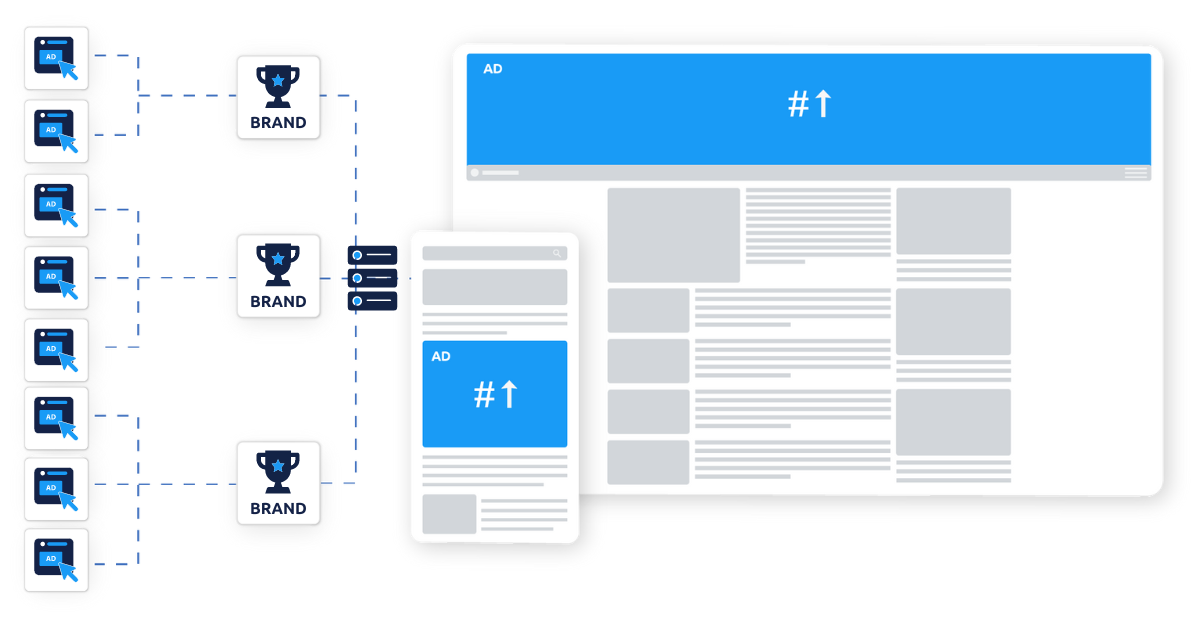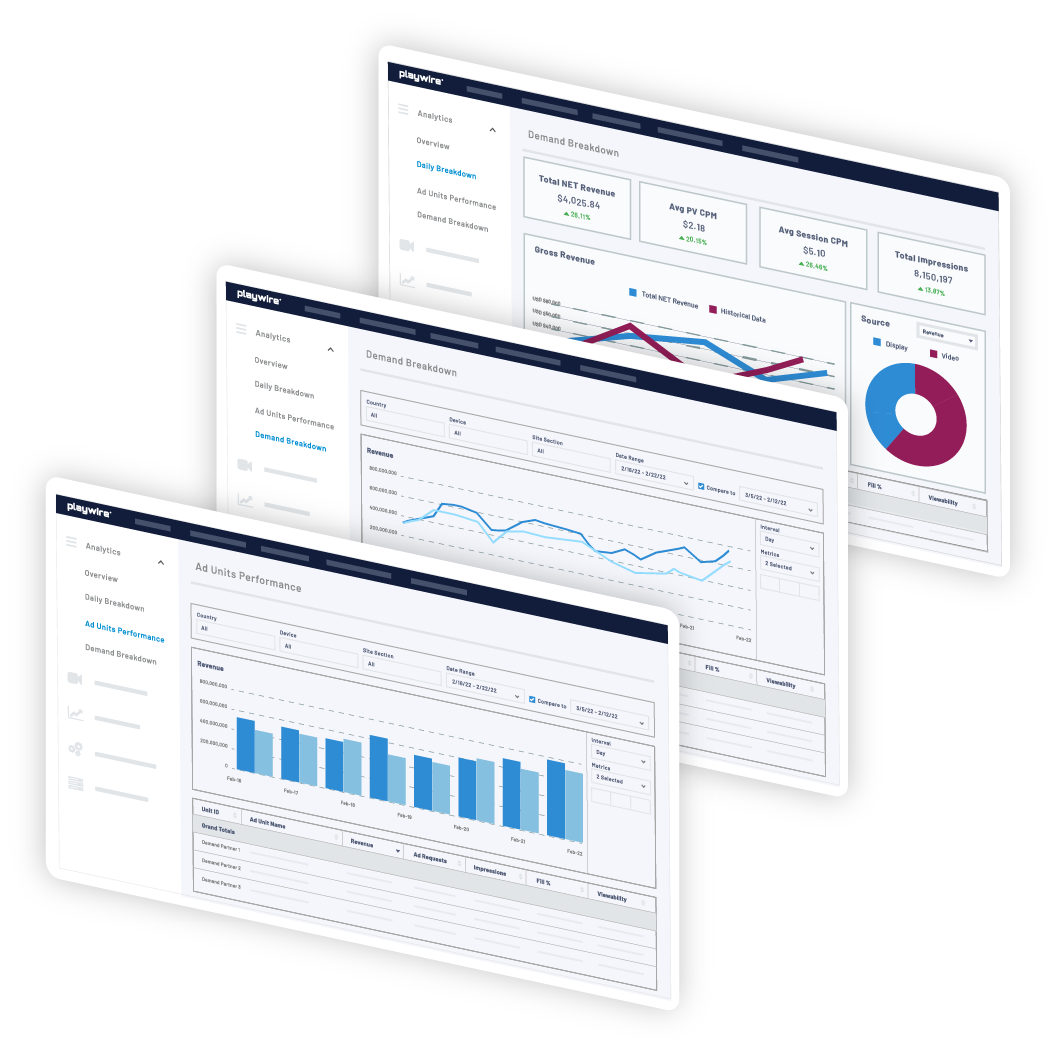the complete guide to Ad Servers
Get a PDF copy of the guide using the form below, or scroll down to read the entire guide right on this page.

Don't Have Time To Read the Entire Guide Now?
We'll email you a downloadable PDF version of the guide and you can read later.
All of our content is generated by subject matter experts with years of ad tech experience and structured by writers and educators for ease of use and digestibility. Learn more about our rigorous interview, content production and review process here.
Built with the expertise of:
INTRODUCTION
Ad servers are where the action happens in digital advertising. But there’s no shortage of confusion when it comes to what ad servers do, how they work, and the place they occupy in the publisher ad tech stack.
Let’s clear up that confusion. The ad tech experts on the Playwire team have put together this comprehensive guide to ad servers to make sure you know exactly what kind of ad server you need and precisely how it is going to work. Read on to learn everything you need to know about the ad serving process.
When you’re ready to take your revenue to the next level, turn to the ad tech experts at Playwire. We know how to configure and deploy ad servers and every other part of the ad tech stack to make your revenue soar. Contact us.
table of
contents
What is an Ad Server?
Let’s begin this guide with the simplest definition of an ad server: An ad server is a piece of advertising technology that places digital ads in front of digital readers or viewers.
To do that, the ad server has to process a lot of information about the ads themselves, the publishers and buyers involved, the user and their data, and much more — in real-time. Ad servers fit squarely into the programmatic ecosystem, so they have to operate as massive decision engines that can facilitate the results of potentially thousands of real-time programmatic auctions per minute.
That sounds pretty complicated, but it’s only the beginning of what ad servers have become over time. In the early days of ad servers, they served the simple function of placing the right ads in front of the right people. But today, they have evolved into something new. Ad servers can now do advertising campaign optimization and management, reporting, and much more.

The tail-end of our definition of ad servers makes it sound like we should be asking what ad servers don’t do. That’s fair, and it’s a common situation in ad tech: The disparate pieces of the ad tech stack start to bleed into each other’s capabilities as different companies develop their products.
But to assume that ad servers are the same as the other parts of the ad tech stack would be a mistake. Still, you hear people use a demand-side platform (DSP), supply-side platform (SSP), ad exchange, and ad network as synonyms for “ad server.”
The problem, of course, is that some ad servers do share some capabilities with these other ad tech tools. However, they are not all one and the same. For example, DSPs allow advertisers and ad agencies to manage their campaigns in much the same way an advertiser-side ad server would allow, but a DSP can manage campaigns across multiple distinct ad servers — not just one.
It’s the same situation for SSPs, except these tools allow publishers to manage their ad inventory across multiple distinct ad servers. Meanwhile, ad networks and exchanges are all about injecting demand for ad inventory into publishers’ programmatic advertising configurations. While they interface with these tools, ad servers do not themselves provide inventory or demand.
The History of Ad Servers
In late 1995, something big was about to happen in ad tech. FocaLink Media Services was about to release the world’s first central ad server to manage the ad placement of display banners on websites.
By February of 1996, FocaLink Media Services had re-launched the ad server and named it SmartBanner. The company would go on to rebrand as AdKnowledge in 1998 and operate its server into the present day.
Meanwhile, ad tech pioneers were hard at work developing the first local ad server. NetGravity was the first to win that race, releasing its local server in early 1996. That server placed early online ads on ‘90s internet giants like Yahoo! and Pathfinder.
By 1999, DoubleClick had acquired NetGravity, and Google would go on to acquire DoubleClick in 2008. Today, Google’s ad server is among the most used and most powerful ad servers on the planet.
How Ad Servers Work
Publishers who monetize with digital advertising include places in their content where ads can go. It might be a rail banner slot for a written article or a pre-roll placement for a video. In any case, creating the place for the ad to go is only step one. On the other side of this equation, you have advertisers who have ad creative they want to get in front of particular audiences.
Ad servers function in between those two ends of the equation to place advertisers’ ads into the publishers’ designated ad slots for viewing by the precise type of user the advertiser is targeting. To do that efficiently and in real-time, ad servers have to be highly sophisticated decision-making engines that take into account user targeting information, ad parameters, ad tags, and more.
Using inputs from SSPs, DSPs, ad networks, and publishers and advertisers themselves, ad servers “serve” ads to users in real-time after accounting for direct-sold ad demand and every factor and contingency introduced into the ad server’s ecosystem.
Here is just a sample of the factors an ad server has to consider potentially millions of times per day for each and every user:
- The location of the user
- The user’s age and gender
- The user’s web browsing history
- The number of times the user has seen each ad the server could serve
- The number of times each has already been seen by other users within a specific time period
After adjusting for these and various other factors, large ad servers may still have a dozen or more ads that could fit the available criteria. That’s when the truly advanced features of the ad server kick in to prioritize particular ads for particular demographics.
On top of all of that, sophisticated ad servers can also produce detailed reporting on the ads they serve and ad impressions they process to the benefit of both the advertiser and publisher.
Benefits of Using an Ad Server
You don’t have to have an ad server in order to run ads, but it’s going to make your life a lot easier. Here are some of the benefits of ad servers for publishers:
Increased Transparency Through Better Reporting
Ad servers bring to the table advanced reporting capabilities and funnel unbelievably large amounts of data into those reports. Simply having the raw data can enable more thorough reporting, but some of the more advanced ad servers will automatically generate custom reports.
Why does that matter for publishers? Because your ability to deliver transparency through more in-depth reporting better demonstrates the value of gaining access to your audience for advertisers. Having clear, actionable numbers to point to enables you to command higher CPMs and even boost your direct sales efforts.

Faster Programmatic Bidding
Ad servers bring additional processing power to publishers’ programmatic setups by lending their sophisticated decision-making engines to the programmatic auction process. They plug into DSPs, SSPs, ad exchanges, and ad networks to efficiently process real-time auctions and serve ad creative to the optimal user at the optimal time. Doing that faster means lower latency and the ability to fill more impressions.
Greater Control Over Ads
When you have greater control over when, how, and which ads are served, you can make changes that increase key metrics like click-through rate (CTR), viewability, and similar. That translates to higher CPMs, which is, of course, the primary goal of most of the ad tech stack for publishers.
More Demand in One Place
A high-quality ad server enables you to incorporate and manage as many demand sources as you want in a single place. That can become extremely helpful in the more advanced stages of the publisher growth cycle, in which you need to add more than a single source of demand in order to increase competition for your ad inventory. Ad servers make managing multiple demand sources — including programmatic and direct demand — much easier.
Types of Ad Servers
Ad servers do a lot. They all have that in common, but they aren’t all the same. In fact, there are several kinds of ad servers, each of which serves a distinct purpose in the world of digital advertising. Here are the main types of ad servers:
First-Party Ad Servers
Third-Party Ad Servers
-
Ad clicks
-
Ad impressions
-
Video completions
-
Viewability
Besides robust reporting, third-party ad servers provide an enormous time-saving benefit to agencies. That’s because they allow agencies to make changes to creative or campaigns in a single place — inside a hosted third-party ad server — and roll them out across the network of publishers, rather than having to make the changes one by one with every single publisher involved in the equation.
Open-Source Ad Servers
Display Ad Servers
Mobile Ad Servers
Mobile ad servers are those that serve advertisements to mobile apps and mobile websites. While serving ads to mobile websites is nearly identical to the process of serving ads to desktop websites, serving ads to mobile apps is a whole different ball game.
To that end, the setup for using a mobile ad server in-app is somewhat different from the setup for other kinds of servers. First, you will have to integrate the software development kit (SDK) of the ad server you have chosen with the SDKs you already have supporting your app. After that technical step — which can be more difficult than it may sound for publishers with little development experience — the integrated mobile app ad server functions much like any other ad server.
Rich Media Ad Servers
Rich media ad servers handle some of the most complex ad units. These are usually the big, splashy, interactive units that turn heads and are considered “premium” and, therefore, are more expensive.
To function as a rich media ad server, a server has to be able to accommodate and process multiple file types per ad, including audio, video, images, and trackers that measure and/or respond to in-ad interactivity.
Video Ad Servers
Whether you have video content you want to monetize with video ads or simply want to run video ads in a small pop-out player beside your text content, you’re likely going to need a video ad server to make it happen. Video ad servers can handle both in-stream and out-stream video advertising, and many are dual-purpose servers in the sense that video is far from the only type of advertising they handle.
Native Ad Servers
Native advertising — in which publishers run ads that are designed to blend in with the typical content they publish — asks something different of ad servers than many other ad unit types. Native ad servers need to be able to not only serve ads in general but serve ads that are seamlessly blended with the content that will surround them on the website or app where they will end up.
That means servers that can accommodate native advertising often have innovative features that customize ad creative to give it the “native” look and feel, and publishers barely have to lift a finger to make it happen.
Ad Server Features
How do you choose the best ad server for you? You can go by a lot of metrics, including user reviews and industry reputation, but ultimately, a major part of the decision is going to come down to the features the ad server offers.
And make no mistake — ad servers can have a ton of possible features. Here are some of the most common and important ad server features broken down into major categories:
Ad Management
-
A simple user interface. You want a user interface that makes inventory or campaign management not just easy, but fast.
-
Traffic forecasting. Accurate predictions about future traffic patterns can help you plan and budget, as well as sell against the numbers.
-
Campaign scheduling. This allows you to set and automate start and end dates for individual campaigns.
-
Support for various ad units. The basics like display banners should be a given, but make sure any ad server you choose supports all IAB-supported standard unit types, as well as any premium ad units you are interested in.
-
Macro location insertion. This allows you to serve ads that include users’ locations.
-
Advanced reporting. To effectively manage ads within your ad server, you need the server to provide detailed, customizable reporting on every conceivable and relevant ad metric.
Ad Delivery and Decision Making
Ultimately, ad servers have to function as massive decision engines to decide which ads to serve to which users at lightning speed. Doing that effectively is going to require some pretty advanced features, such as the following:
- Capping. This refers to settings that stop campaigns from serving after they have met a particular spend limit each day.
- Frequency capping. This is the ability to control how often and how many times in total a particular ad is shown to an individual user.
- Multi-channel ad serving. This is the ability of an ad server to serve ads across various channels, such as web, mobile, and over-the-top (OTT).
- Sequencing of ad creatives. This enables you to control the order in which a series of ads is shown to users.
Targeting
- Location-based targeting. Ad servers should be able to target users based on where they are at the time they initiate an auction.
- Time targeting. A high-quality ad server should allow you to serve targeted ads to certain users based on the time of day, which may dictate the type of user most likely to be using the site or app.
- Technology-based targeting. Some ads would be better served to smartphone users, and good ad servers will allow you to target based on device, including mobile, desktop, tablet, and OTT.
-
Behavioral targeting. Users’ online interests and search history can tell you a lot about what kinds of ads they might best respond to. That’s why you want an ad server that facilitates targeting based on these considerations.
-
Demographic targeting. Income, nationality, marital status, language, and various other demographic descriptors dictate how well an ad will resonate with particular audiences. Your ad server should allow you to target users based on demographic information.
-
Retargeting. This refers to an ad server’s ability to cooperate with tools that serve ads to users based on the brand websites they have interacted with in the past. The ability to “follow” users around the internet gives brands a much better shot at making a sale, making it a valuable feature for both advertisers and publishers who want a slice of their advertising budgets.
Popular Ad Servers
Publishers tend to be pretty selective when it comes to what they allow into their ad tech stacks. We get it — your choices here have a strong impact on your bottom line, and you notice any inefficiencies or malfunctions pretty quickly when your revenue takes a dip.
With that said, here are seven of the most popular ad servers for publishers:
To learn more about each of these ad server choices, check out our in-depth guide to the best ad servers for publishers.
The Cost of an Ad Server
The costs of ad servers vary widely, depending on a huge number of factors. In fact, one of the most common and best ad servers available — Google Ad Manager — is completely free to publishers who are not yet amassing tens of millions of impressions.
There are several free options, but there are also some paid ad servers. These tools are usually priced by their capabilities — the more features you get, the more you pay. However, some ad servers operate on a sliding scale, in which you pay less per ad impression as you funnel more impressions through them.
Another consideration when determining the total cost of an ad server is how much it is likely to improve your digital advertising operations. Small improvements in your operations can lead to massive increases in advertising revenue over time, effectively making the right ad server pay for itself several times over.
Self-Serve vs. Managed Ad Severs
By this point, we have established that ad servers are big, complex pieces of advertising technology. Publishers are used to having to deal with big, complex pieces of ad tech, of course, but should they have to manage their own ad servers? As it turns out, the answer is no — you don’t have to.
Plenty of third-party ad tech vendors have popped up to solve the ad server problem for publishers. They promise ad server selection, integration, and management, and they add that their oversight is meant to increase ad revenue through smart yield optimization tactics.
What’s the catch? You usually have to agree to do revenue share with the provider. (And while some do offer other fee structures, this is the most common and, generally, most fair approach.) That may immediately sound like a downside, but it isn’t unless the provider can’t actually increase your revenue.
That’s because any provider of ad server management worth their salt will be able to increase a publisher’s revenue by more than their revenue share fee is worth, thus paying for themselves.
However, many publishers do choose to go the DIY route. With that approach, make sure you are setting aside enough time, money and manpower to truly manage your ad server in a way that will maximize your revenue.
Ad Server FAQs
Ad servers are like a lot of pieces of ad tech in the sense that, the more you learn about them, the more questions you’re likely to have. Here are the answers to a few common questions about ad servers.
Is Google Ad Manager an ad server?
Google Ad Manager (GAM) contains an ad server as part of its brand offerings to publishers. While the ad server is just one component of GAM’s offerings, it’s important to note that GAM’s ad server is considered one of the premier servers available today.
How do ad servers make money?
If you currently rely on third-party cookies of any kind to gather data on users, and if that data informs audience segments and other strategies to increase your CPMs, you need to consider an identity solution before Google finally kills the third-party cookie once and for all.
Which ad server is best?
It’s difficult to say which ad server is best because the answer depends so heavily on your unique needs and how large of a publisher you are. For example, Google Ad Manager provides a comprehensive ad server that could reasonably serve the needs of many small to medium publishers on its own. In other cases, some publishers need ad servers that are more readily equipped to balance premium ad units or direct-sold advertising.
Ultimately, the best ad server is the one that best serves your needs as a publisher without costing you too much in time or money. And there is no shame in trying different ad servers to try to find the perfect fit.
Do I need an ad server?
This question might be better phrased as “Do I need a dedicated ad server?” That’s because, in all likelihood, you’re going to use an ad server of some kind if you do digital advertising. The question, then, is whether you need your own ad server to allow you to manage your inventory.
If you are a new or very small-scale publisher, the answer is probably no — you don’t necessarily need a dedicated ad server. However, as your audience grows and you begin to try out more advanced digital advertising strategies, you may find that you do, in fact, need your own ad server.
Should I build my own ad server?
Unfortunately, building your own ad server is an option reserved for only the largest publishers in the world — those with millions of dollars and whole teams of developers lying around.
To build the basic functionality of ad serving technology is an enormous undertaking in and of itself, but then you would have to ensure that the server could integrate with the many other parts of the ad tech ecosystem. Then, for anyone to be able to use it, you would have to get it approved by the major agencies — yet another years-long undertaking.
The good news is that you don’t have to build your own ad server. There are plenty of high-performance ad servers available to publishers right now. Building your own would likely offer you a few advantages over the options that already exist.
Can ad servers accommodate direct-sold ads?
Yes. Many ad servers can balance direct-sold advertising with programmatically sold advertising. In fact, this capability is one of the key reasons why publishers seek out ad servers. They want the high yield of direct sales and the consistency and volume of programmatic, and they want to manage it all in a single place: a high-quality ad server.
Get the Best Ad Server (and Everything Else) with Playwire

What ad servers do is simple, but choosing one and understanding how they work is complicated. Fortunately, you can make the whole situation a little less complicated and much less stressful when you reach out to Playwire.
We handle every aspect of our publishers’ digital advertising efforts, from ad server selection and implementation to direct sales and header bidding. We’ve built proprietary technology that drives real and constant results for publishers like you.
Ready to stop stressing about revenue and start enjoying more of it? Then you’re ready to reach out to Playwire. Contact our team online.
Related Content
Feel free to visit our Complete Ad Server Resource Center, or dive deeper into any of these related articles:
- Ad Tech Build vs. Buy: Ad Serving
- Ad Server vs. Ad Network
- Video Ad Servers vs. Display Ad Servers
- What is an Open-Source Ad Server?
- First-Party Ad Servers vs. Third-Party Ad Servers
- Best Ad Servers for Publishers in 2022
- What is an Ad Server and How Does it Work?
- The 7 Most Popular Ad Servers for Video Ads
- 8 Types of Ad Servers and the Advantages and Disadvantages of Each
Amplify
Your Ad Revenue
Accelerate your business and uncomplicate your ad tech stack, because you deserve a partner and a platform that demands more for you.

